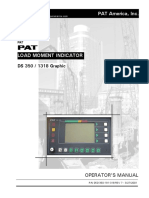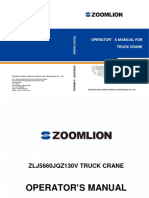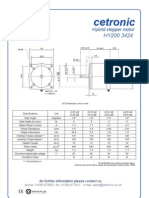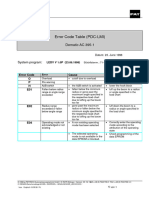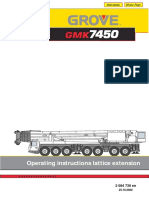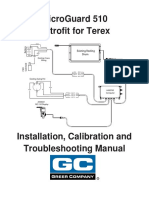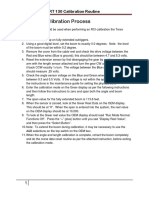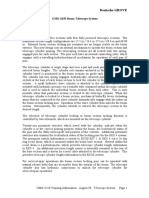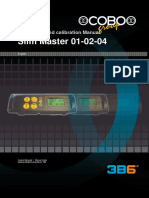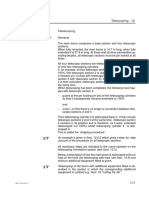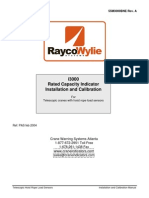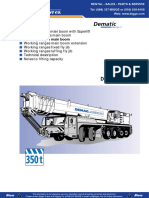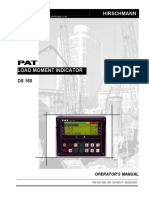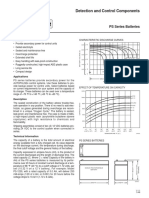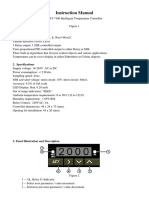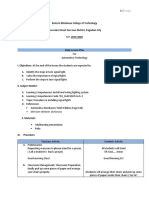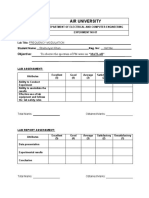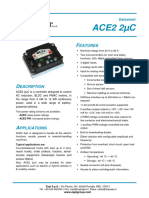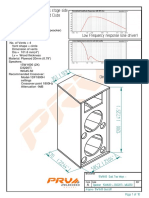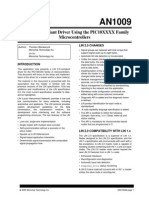DS350GM Service - SkyAzul
DS350GM Service - SkyAzul
Uploaded by
Hamilton AlvarengaCopyright:
Available Formats
DS350GM Service - SkyAzul
DS350GM Service - SkyAzul
Uploaded by
Hamilton AlvarengaCopyright
Available Formats
Share this document
Did you find this document useful?
Is this content inappropriate?
Copyright:
Available Formats
DS350GM Service - SkyAzul
DS350GM Service - SkyAzul
Uploaded by
Hamilton AlvarengaCopyright:
Available Formats
DS350GM
SERVICE MANUAL
SkyAzúl, Equipment Solutions www.skyazul.com 301-371-
6126
NOTICE
SkyAzúl makes no warranty of any kind with regard to this material, including, but not limited to, the
implied warranties of merchantability and/or its fitness for a particular purpose.
SkyAzúl will not be liable for errors contained in this manual or for incidental or consequential
damages in connection with the furnishing, performance, or use of this manual. This document
contains proprietary information, which is protected by copyright, and all rights are reserved.
No part of this document may be photocopied, reproduced, or translated to another language without
the prior written consent of SkyAzúl.
SkyAzúl reserves proprietary rights to all drawings, photos and the data contained therein. The
drawings, photos and data are confidential and cannot be used or reproduced without the written
consent of SkyAzúl. The drawings and/or photos are subject to technical modification without prior
notice.
All information in this document is subject to change without notice.
SkyAzúl, Inc.
200 W. Main Street, Suite, 2A
Middletown, MD 21769
Fax 301-371-0029
info@skyazul.com
SkyAzúl, Equipment Solutions www.skyazul.com 301-371-6126
SkyAzúl, Equipment Solutions www.skyazul.com 301-371-6126
Service Manual DS 350 GM
TABLE OF CONTENTS
1 GENERAL INFORMATION ................................................................................. 1
2 WARNINGS .................................................................................................... 2
3 FLOWCHARTS ................................................................................................ 3
3.1 GENERAL FLOWCHART...............................................................................3
3.2 ERROR CODE DISPLAY ...............................................................................4
3.3 LEVER LOCKOUT ACTIVATED ...................................................................13
3.4 BROKEN LENGTH CABLE...........................................................................14
3.5 NO DISPLAY ............................................................................................15
3.6 ANTI-TWO BLOCK PROBLEM .....................................................................17
3.7 LENGTH READING PROBLEM .....................................................................20
3.8 ANGLE READING PROBLEM .......................................................................23
3.9 LOAD READING PROBLEM.........................................................................25
3.10 BAD DATA TRANSFER BETWEEN CONSOLE & CENTRAL UNIT OR
INTERFERENCE PROBLEM..........................................................................26
4 DRAWINGS .................................................................................................. 29
4.1 DRAWING 1. ELECTRICAL WIRING FOR CENTRAL UNIT TO PRESSURE
TRANSDUCERS AND CRANE .....................................................................29
4.2 DRAWING 2. ELECTRICAL WIRING FOR CENTRAL UNIT TO CONSOLE...........30
4.3 DRAWING 3. ELECTRICAL WIRING FOR CENTRAL UNIT TO CABLE
REEL/ANTI-TWO BLOCK ............................................................................31
4.4 DRAWING 4. CENTRAL UNIT - PARTS LIST.................................................32
4.5 DRAWING 6. CABLE REEL - PARTS LIST .....................................................36
4.6 DRAWING 7. CENTRAL UNIT MAIN BOARD LAYOUT ...................................38
4.7 DRAWING 8. CONSOLE CONNECTION BOARD ............................................39
4.8 DRAWING 9. CENTRAL UNIT ANALOG INPUT MODULE ...............................40
5 PROCEDURES ............................................................................................... 41
5.1 PROCEDURE 1. STRAIN RELIEF INSTALLATION ...........................................41
5.2 PROCEDURE 2. EPROM LOCATION AND INSTALLATION ..............................42
5.3 PROCEDURE 3. MAIN BOARD REPLACEMENT .............................................43
5.4 PROCEDURE 4. PRESSURE TRANSDUCER ZERO ADJUSTMENT ....................44
5.4.1 USING GRAPHIC CONSOLE FOR ZERO-SETTING OF PRESSURE TRANSDUCER
& FORCE INPUTS ............................................................................ 44
5.5 PROCEDURE 5. LENGTH AND ANGLE SENSOR ADJUSTMENT ......................45
6 THEORY ....................................................................................................... 46
6.1 THEORY 1. OPERATION OF BOOM LENGTH SENSOR ...................................46
Measuring current:.............................................................................................46
Measuring voltage: ............................................................................................46
6.2 THEORY 2. OPERATION OF PISTON SIDE LOAD SENSOR .............................47
6.3 THEORY 3. OPERATION OF ROD SIDE LOAD SENSOR..................................48
6.4 THEORY 4. OPERATION OF ANGLE SENSOR ...............................................49
SkyAzúl, Equipment Solutions www.skyazul.com 301-371-6126
General Information 1
1 GENERAL INFORMATION
This troubleshooting manual is designed to assist a service or maintenance person in identifying
system problem areas or malfunctions. A digital voltmeter with the capability to also measure
current will be required. Regular maintenance and service tools will also be required. NOTE:
Knowledge of how to use a voltmeter to measure both voltage and current is assumed.
REFERENCE:
For system operation, refer to the operator’s manual for the console. This may differ from crane
manufacturer and model.
Section 3.1 is a general flow chart that directs you to detailed flow charts and sections.
Section 3.2 provides a list of error codes, error, cause, and possible action for the error.
Sections 3.3 – 3.11 provide detailed flow charts to define and correct the root cause.
Section 4 provides drawings that will be referenced for troubleshooting.
Section 5 provides procedures that will be referenced for troubleshooting.
Section 6 provides drawings for the theory of operation of all the different sensing devices used
in the DS350G Modular System. Use these reference drawings to better understand the
operation of the system.
SkyAzúl, Equipment Solutions www.skyazul.com 301-371-6126
2 Service Manual DS 350 GM
2 WARNINGS
The LMI is an operational aid that warns a crane operator of approaching overload conditions
and overhoist conditions that could cause damage to equipment and personnel. Therefore, the
device is not, and shall not be, a substitute for good operator judgment, experience and use of
accepted safe crane operating procedures.
The responsibility for the safe crane operation shall remain with the crane operator who shall
ensure that all warnings and instructions supplied are fully understood and observed.
Prior to operating the crane, the operator must carefully and thoroughly read and understand
the information in the crane’s operating manuals to ensure that the operator knows the
operation and limitations of indicator and crane.
PAT Load Moment Indicator (LMI) DS 350 Modular
The PAT Load Moment Indicator (LMI) DS 350 Modular has been designed to provide the crane
operator with the essential information required to operate the machine within the designed
parameters. Using different sensing devices, the DS 350 Modular LMI monitors various crane
functions and provides the operator with a continuous display of the crane’s capacity. The
display continually changes as the crane moves through the motions needed to make a lift.
If non-permitted conditions are approached, the DS 350 LMI will warn the operator by sounding
an audible alarm and lighting a warning light. In addition the LMI system has the capability to
provide a signal to the solenoids and thereby locking out those functions that may aggravate the
crane’s condition.
SkyAzúl, Equipment Solutions www.skyazul.com 301-371-6126
Flowcharts 3
3 FLOWCHARTS
3.1 GENERAL FLOWCHART
This section explains how to handle a problem that may arise with the PAT DS 350 Modular LMI.
The procedures are given in flowchart format for the following sections. Start with the general
flowchart below that will guide you to one of the detailed flowcharts shown in this section. The
drawings and procedures that are referenced in these sections can be found in Sections 4 and 5.
What’s Wrong?
Error Code Displayed Go to Section 3.1
Lever Lockout Activated Go to Section 3.3
Broken Length Cable Go to Section 3.4
No display Go to Section 3.5
Anti-Two Block Problem Go to Section 3.6
Length Reading Problem Go to Section 3.7
Angle Reading Problem Go to Section 3.8
Load Reading Problem Go to Section 3.9
Bad Data Transfer/Interference
Between Central Unit and Go to Section 3.10
Console
SkyAzúl, Equipment Solutions www.skyazul.com 301-371-6126
4 Service Manual DS 350 GM
3.2 ERROR CODE DISPLAY
PROBLEM: Error code displayed. Lever lockout activated. Warning lights on.
ERROR ERROR CAUSE ACTION
CODE
E01 Minimum radius or Fallen below the minimum Lower boom back to a radius or
maximum angle range radius or above the angle angle given in the load chart.
exceeded given in the load chart due
to raising the boom to far.
E02 Maximum radius or The maximum radius or Raise boom back to a radius or
minimum angle range minimum angle given in the angle given in the load chart.
exceeded load chart was exceeded
due to lowering the boom
too far.
E03 Prohibited slewing Slewing range prohibited Slew back into admissible
range (no load area) with load. range.
E04 Operating mode not Operating mode switch in Set operating mode switch
available the console set incorrectly. correctly to the code assigned
Operating mode is not to the operating mode of the
permissible with actual crane.
crane configuration.
E05 Length range not Boom has been extended Refer to Section 3.7.
permitted too far or not far enough. Retract or extend boom to
Length sensor adjustment correct length given in the load
changed; i.e. length sensor chart.
cable slid off the cable
drum.
E06 Fallen below angle Fallen below the minimum Luff in the jib to a radius or
range with luffing jib jib angle specified n the angle specified in the load
operation. respective load chart due to chart.
luffing out the jib too far.
E07 No acknowledgment Overload relay is stuck, Replace main board in central
signal from overload defective or not being unit. Refer to Drawing 4 and
relay (K1). selected. Procedure 3 in Section 5.3
E08 No acknowledgment Anti-Two-Block switch Replace main board in central
signal from Anti-Two- relay is defective or not unit. Refer to Drawing 4,
Block switch relay being selected. Section 4.4, and Procedure 3 in
(K2). Section 5.3.
E10 Error in length With the boom fully Refer to Section 3.7.
measurement retracted, the length differs
by more than 2%.
SkyAzúl, Equipment Solutions www.skyazul.com 301-371-6126
Flowcharts 5
ERROR ERROR CAUSE ACTION
CODE
E11 Fallen below limit for a.) Cable between length Refer to Section 3.7
the measuring sensor and central unit a.)Check cable and connector
channel “length”. defective, not connected or b.) Check and reset length
water in the connectors. sensor Potentiometer. Refer to
b.)Length sensor Procedure 5.
Potentiometer defective. c.) Check signal on main board
c.)Electronic board in the and analog input module.
measuring channel
defective.
E12 Fallen below lower a.) Cable leading from the Refer to Section 3.9
limit value for the central unit to the pressure a.)Check cable and connector
measuring channel transducer defective, loose b.)Check pressure transducer
“pressure transducer or water in the connector. and reset pressure channel.
piston side”. b.)Pressure transducer on c.) Check signal on main board
piston side defective. and analog input module.
c.)Electronic component in
the measuring channel
defective.
E13 Fallen below lower a.)Cable leading from the Refer to Section 3.9
limit value for the central unit to the pressure a.)Check cable and connector
measuring channel transducer defective, loose b.) Check pressure transducer
“pressure transducer or water in the connector. and reset pressure channel.
rod side”. b.)Pressure transducer on c.) Check signal on main board
rod side defective. and analog input module.
c.)Electronic component in
the measuring channel
defective.
E14 Fallen below lower a.)Cable leading from the a.) Check cable and connectors
limit value for the central unit to the pressure as well and replace, if
measuring channel transducer defective, loose necessary.
“force”. or water in the connector. b.)Check force transducer.
b.)Force transducer c.) Check signal on main board
defective. c.)Electronic and analog input module.
component in the
measuring channel
defective.
E 15 Fallen below lower a.)Cable from central unit Refer to Section 3.8
limit value for the to the length/angle sensor a.) Check cable.
measuring channel defective or loose. b.) Check angle sensor and
“angle main boom”. b.)Angle sensor defective. reset adjustment. Refer to
c.)Electronic component in Procedure 5
the measuring channel c.) Check signal on main board
defective. and analog input module.
SkyAzúl, Equipment Solutions www.skyazul.com 301-371-6126
6 Service Manual DS 350 GM
ERROR ERROR CAUSE ACTION
CODE
E16 Fallen below lower a.)Cable from central unit a.) Check cable.
limit value for to angle sensor defective or b.) Check angle sensor and
measuring channel disconnected or water reset adjustment.
“Luffing Jib Angle”. inside the plug. c.) Check signal on main board
b.)Angle sensor defective. and analog input module.
c.)Electronic component in
the measuring channel
defective.
E17 Fallen below lower a.)Cable leading from the a.) Check cable and
limit value for the central unit to the sensor of connectors.
measuring channel 7. channel 7 defective, loose b.) Check sensor of channel 7
or water in the connectors. and reset adjustment.
b.)Sensor of channel 7 c.) Check signal on main board
defective. and analog input module.
c.)Electronic component in
the measuring channel 7
defective.
E18 Outrigger overloaded Front outrigger overloaded Check outrigger sensor
E19 Error in the reference Electronic component on Replace main board. Refer to
voltage. the main board defective. Drawing 4 and Procedure 3.
E1A Below limiting value a.)Cable from central unit a.) Check cable.
for slewing angle 1. to the slewing angle sensor b.) Check and reset slewing
defective or loose. angle potentiometer.
E1B Below limiting value b.)Slewing angle c.) Check signal on main board
for slewing angle 2. potentiometer defective. and analog input module.
c.)Electronic component in
the measuring channel
defective on main board.
E21 Upper limiting value a.)Cable from central unit Refer to Section 3.7
for the measuring to the length/angle sensor a.) Check cable and connector
channel “length” defective or loose. b.) Check and reset length
exceeded. b.)Length potentiometer sensor Potentiometer. Refer to
defective. Procedure 5.
c.)Electronic component in c.) Check signal on main board
the measuring channel and analog input module.
defective on main board.
SkyAzúl, Equipment Solutions www.skyazul.com 301-371-6126
Flowcharts 7
ERROR ERROR CAUSE ACTION
CODE
E22 Upper limiting value a.)Cable from central unit Refer to Section 3.9
for the measuring to the pressure transducer a.) Check cable and connector
channel “pressure defective, loose or water in b.) Check pressure transducer
piston side” the plug. and reset pressure channel.
exceeded. b.)Pressure transducer on c.) Check signal on main board
piston side defective. and analog input module.
c.)Electronic component in
the measuring channel
defective on main board.
E23 Upper limit value for a.) Cable lead in from the Refer to Section 3.9
the measuring central unit to press trans a.) Check cable and connector
channel “pressure defective, not connected or b.) Check pressure transducer
transducer rod side” water in the connectors. and reset pressure channel.
exceeded. b.) Pressure transducer on c.) Check signal on main board
rod side defective. and analog input module.
c.) Electronic component in
the measuring channel
defective.
E24 Upper limit value for a.) Cable leading from the a.) Check cable and connectors
the measuring central unit to the force as well and replace, if
channel “force” transducer defective, not necessary. b.) Check force
exceeded. connected or water in the transducer.
connectors. c.) Check signal on main board
b.) Force transducer and analog input module.
defective.
c.) Electric component in
the measuring channel
defective.
E25 Upper limit value for a.) Cable leading from the Refer to Section 3.8
the measuring central unit to the a.) Check cable.
channel “angle main length/angle sensor b.) Check angle sensor and
boom” exceeded. defective, loose or water in reset adjustment. Refer to
the connectors. Procedure 5
b.) Angle sensor defective c.) Check signal on main board
c.) Electronic component in and analog input module.
the measuring channel
defective.
E26 Upper limit value for a.) Cable leading from the a.) Check cable.
the measuring central unit to the jib angle b.) Check angle sensor and
channel “Luffing Jib sensor defective, loose or reset adjustment.
Angle” exceeded. water in the connectors. c.) Check signal on main board
b.) Jib angle sensor and analog input module.
defective. c.) Electronic
component in the
measuring channel
defective.
SkyAzúl, Equipment Solutions www.skyazul.com 301-371-6126
8 Service Manual DS 350 GM
ERROR ERROR CAUSE ACTION
CODE
E27 Upper limit value for a.) Cable leading from the a.) Check cable and
the measuring central unit to the sensor of connectors.
channel 7 exceeded. channel 7 defective, loose b.) Check sensor of channel 7
or water in the connectors. and reset adjustment.
b.) Sensor of channel 7 c.) Check signal on main board
defective. and analog input module.
c.) Electronic component in
the measuring channel 7
defective.
E29 Reference voltage a.) The total of the supply a.) Check supply voltages.
defective. and the reference voltages b.) Replace main board or
on MP10 is more than analog input module. Refer to
3.3V Drawing 4 and Procedure 3
b.) A/D converter Steps 1,2,4, 11,12..
defective.
E2A Above limiting value a.)Cable from central unit a.) Check cable.
for slewing angle 1. to the slewing angle sensor b.) Check and reset slewing
defective or loose. angle potentiometer.
E2B Above limiting value b.)Slewing angle c.) Check signal on main board
for slewing angle 2. potentiometer defective. and analog input module.
c.)Electronic component in
the measuring channel
defective on main board.
E31 Error in the system a.) EPROM with system a.) Replace system program
program. program defective. EPROM
b.) Electronic component b.) Check signal on main board
on the main board and analog input module.
defective.
E37 Error in the program a.) EPROM with system a.) Replace system program
run program defective. EPROM.
b.) Electronic component b.) Check signal on main board
on the main board and analog input module.
defective.
E38 System program and The system program in the Replace system program
Data EPROM do not LMI does not correspond to EPROM or Data EPROM. Refer
match. the programming in the to Procedure 2
data EPROM
E39 System program and The system program in the Replace system program
TLK EPROM do not LMI does not correspond to EPROM or TLK EPROM. Refer
match. the programming in the to Procedure 2
data EPROM
E41 Error in the external Defective electronic Replace main board or analog
RAM. component. input module. Refer to Drawing
4 and Procedure 3, Steps
1,2,4, 11, and 12.
SkyAzúl, Equipment Solutions www.skyazul.com 301-371-6126
Flowcharts 9
ERROR ERROR CAUSE ACTION
CODE
E42 Error in the external Internal defect in digital Exchange write/read memory
write/read memory part of CPU. (CMOS-RAM). Replace CPU
(RAM). Part 1 module. Refer to Drawing 4
and Procedure 3, Steps 1-3,
13,14.
E43 Error in the external Internal defect in digital Exchange write/read memory
write/read memory part of CPU. (CMOS-RAM). Replace CPU
(RAM). Part 2. module. Refer to Drawing 4
and Procedure 3, Steps 1-3,
13,14.
E45 Redundancy error in Defective electronic Replace analog input module.
A/D conversion. component. Refer to Drawing 4 and
Procedure 3, Steps 1,2,4,
11,12.
E46 Error in A/D Defective electronic Replace analog input module.
conversion. component. Refer to Drawing 4 and
Procedure 3 Steps 1,2,4,
11,12.
E47 Malfunction in the Internal defect in digital Replace CPU module. Refer to
monitored write/read part of CPU Drawing 4 and Procedure 3
memory. Steps 1-3, 13,14
E48 Cyclic RAM test: Internal defect in digital Replace CPU module. Refer to
Error in the internal part of CPU Drawing 4 and Procedure 3
write/read memory. Steps 1-3, 13,14
E51 Error in data EPROM. EPROM Module not bridged Replace Data EPROM. Make
correctly sure BR3 on the main board is
Data EPROM on the main installed. Refer to Procedure 2.
board defective.
E52 Error in load chart EPROM Module not bridged Replace EPROM Module and
EPROM. correctly reset pressure channels. Refer
Data EPROM on the main to Drawing 4 and Procedure 4.
board defective.
E56 Error in crane data Memory module wrongly Bridge memory module acc. To
EEPROM. bridged. memory type
Replace crane data EEPROM
Crane data EEPROM Replace EPROM Module and
defective reset pressure channels. Refer to
Drawing 4 and Procedure 4.
SkyAzúl, Equipment Solutions www.skyazul.com 301-371-6126
10 Service Manual DS 350 GM
ERROR ERROR CAUSE ACTION
CODE
E57 Error in serial crane Serial crane data EEPROM Write data on the serial crane
data EEPROM. does not contain valid data. data EEPROM (by means of test
program or on-line function),
then restart the LMI
Replace EPROM Module and
Memory module defective reset pressure channels. Refer to
Drawing 4 and Procedure 4.
E58 Error in the serial No valid data in the serial Write data on the serial analog
analog data EEPROM. analog data EEPROM. data EEPROM by means of the
test program, then, restart the
LMI
LMI main board defective. Replace LMI main board.
E69 Error in the load chart Memory module wrongly Bridge memory module acc. to
EPROM bridged memory type
The number of the Load chart EPROM Replace load chart EPROM
selected EPROM base defective
and the programmed
value are not identical
E70 Error in digital output Central unit unable to a.) Check supply voltage.
module. correspond with digital b.) Replace digital output
output module. module.
E71 Incorrect a.) Anti Two-block relay is Replace main board. Refer to
acknowledgment of stuck or defective. Drawing 4 and Procedure 3.
the 1. Relay on the b.) Anti Two-Block relay is
main board. not being selected due to a
break on the main board.
E72 – Analogous to E71 for Analogous to E71 for the Analogous to E71 for the relays
E77 the relays 2...7. relays 2...7. 2..7.
E84 Wrong rigging The selected rigging Select another rigging condition
condition. condition is not contained in Check the programming in the
the data EPROM. data EPROM.
E85 Error in the radius The computed radius is too Check the programming in the
determination small (negative deflection) data EPROM.
E89 Change of the The operating mode switch Lower the load and set the
operating code during in the console was used operating mode switch correctly
lifting a load. during lifting a load. to the code assigned to the
actual operating mode of the
crane.
SkyAzúl, Equipment Solutions www.skyazul.com 301-371-6126
Flowcharts 11
ERROR ERROR CAUSE ACTION
CODE
E 91 No data transmission a.)24V supply of console a.) Check 24V at terminal X1 of
from console to interrupted. console electronics.
central unit. (Refer to b.)Interruption or b.) Check the connection
Section 9) accidental ground in the between console electronics
line from console and central unit.
electronics to central unit. c.) If accidental ground occurs,
c.)Transmitter/receiver the transmitter module in the
module defective. console electronics can be
damaged. Replace the console
electronics or main board
respectively.
E92 Error in the data a.) Temporary interruption a.) Check the connection
transmission from of the data line from between console electronics
console to central console electronics to and central unit.
unit. (Refer to also central unit. b.)
Section 3.10) Transmitter/receiver
module defective.
E93 Error in the data a.) Temporary interruption Refer to Section 3.10.
transmission from of the data line from a.) Check the connection
central unit to console electronics to between console electronics
console. (Refer to central unit. b.) and central unit.
also Section 3.10) Transmitter/receiver b.) Replace console electronics
module defective. or main board respectively.
E94 No data transmission a.) Interruption or Refer to Section 3.10.
for central unit to accidental ground in the a.) Check the connection
console. (Refer to line from console between console electronics
also Section 3.10) electronics to central unit. and central unit. If you find an
accidental ground, the
transmitter module in the
console electronics can be
damaged. Replace the console
electronics.
b.) Transmitter/receiver b.) Replace console electronics
module defective. or main board respectively.
c.) Data-EPROM defective. c.)Check data EPROM.
d.) CPU defective. d.) Replace CPU module. Refer
to Drawing 4 and Procedure 3
e.) Electromagnetic Steps 1-3, 13,14.
interference (when e.) Eliminate interference
switching contractors or source by inverse diodes or
valves) varistors.
SkyAzúl, Equipment Solutions www.skyazul.com 301-371-6126
12 Service Manual DS 350 GM
ERROR ERROR CAUSE ACTION
CODE
E95 Error in the crane data a.) Data EPROM defective a.) Replace data EPROM
EPROM b.) Position of jumper for b.) Check the jumper position
the selection of the type of
EPROM is wrong c.) Replace CPU module. Refer
c.) Electronics component to Drawing 4 and Procedure 3
on the main board Steps 1-3, 13,14
defective.
E96 Error in the internal CPU or main board of the Replace CPU module. Refer to
RAM of the CPU of console defective Drawing 4 and Procedure 3
the console Steps 1-3, 13,14
E97 Error in the external a.) External RAM of the a.) Replace console main board
RAM of the CPU of console defective
the console b.) Electronic component b.) Replace console main board
on the main board Refer to Drawing 5.
defective.
E98 Wrong jumper position a.) The jumper position BR a.) Check the jumper position
in the console 9/BR 10 in the console
does not correspond to the
actual type of central unit.
b.) Electronic component b.) Replace console main board
on the main board Refer to Drawing 5.
defective.
EAB Short circuit in the A2B Short circuit in the A2B Refer to Section 3.6.
switch circuit switch Replace A2B switch
Short circuit in the cable to
the A2B switch Replace cable to the A2B
switch
Electronic component on
the analog input module Check analog input module.
defective. Replace if necessary., Refer to
Drawing 4 and Procedure 3
Steps 1,2,4, 11,12.
Note:
If an error message is displayed which is not contained in above list, please contact the PAT service
department.
SkyAzúl, Equipment Solutions www.skyazul.com 301-371-6126
Flowcharts 13
3.3 LEVER LOCKOUT ACTIVATED
PROBLEM: The lever lockout system of the crane is activated. Crane movements “hoist up”, “telescope
out”, and “boom down” are stopped. Crane is not in overload or two-block condition.
Start
Use the key switch and the LMI by-pass button on the console to
override the LMI. Refer to the Operator’s Handbook for LMI override
instructions (pages12 and 13).
Corrected YES
NO
Does console indicate Anti-Two-block warning?
NO YES
If console display are If the display Load Moment
Fault in crane electric blank. The fault is Fault in Anti-Two Limit Light is lit. The fault is
or hydraulic system. located in power supply, Block system. located in LMI, cables, wiring,
wiring or fuses . fuses, or console.
Check lever lockout
system in crane Go to Section 3.5 Go to Section 3.6 Read error code displayed on
service manual. console & go to Section 3.2.
SkyAzúl, Equipment Solutions www.skyazul.com 301-371-6126
14 Service Manual DS 350 GM
3.4 BROKEN LENGTH CABLE
PROBLEM: Damaged or broken length cable.
Replace length cable using the following procedure:
Refer to Section 4 for the following drawings:
Drawing 3 - Electrical Wiring Central Unit to Cable Reel
Drawing 6 - Cable Reel - Parts List
1. Cut old cable at cable drum.
2. Disconnect damaged length cable from junction box at the boom nose. Refer to Drawing 3.
3. Open cable reel cover and disconnect wiring from terminal block. Pull 7 conductor cable out of
strain relief. Note: Mark wires to make re-connection simpler.
4. Remove cable reel from mounting brackets.
5. Remove damaged length cable, which is mounted to the slip rings in the cable reel, from slip
ring terminal. Refer to Drawing 3.
6. On the back side of the cable reel, open the strain relief attached to the axle in the center of
the drum. Pull existing length cable out of the cable reel.
7. Pull new length cable through the hole, pipe and strain relief and push it through the axle of the
reeling drum. Tighten new strain relief to ensure sealing.
8. Reconnect the length cable to the slip ring. Refer to Drawing 3.
9. Remount cable reel to the boom.
10. Turn reeling drum clockwise to spool the new cable neatly onto the drum.
11. Set pre-load on cable reel by turning the drum counter-clockwise 5 to 8 turns.
12. Run the new length cable through the cable guides and wrap the length cable around the boom
tip anchor pin (4 or 5 wraps) and secure with tie wraps. Leave enough length cable to connect
into the boom tip junction box.
13. Connect the length cable into the boom tip junction box. Refer to Drawing 3.
14. Reset length potentiometer in length angle transducer (screw is located in center of white gear);
with boom fully retracted, turn potentiometer carefully counter-clockwise until it stops.
Recheck length and angle display. Refer to Procedure 5 in Section 5.5.
SkyAzúl, Equipment Solutions www.skyazul.com 301-371-6126
Flowcharts 15
3.5 NO DISPLAY
PROBLEM: Blank console display with no warning light shown. All crane moments have
been stopped.
START
Check fuses in central unit.
Correct? NO Replace fuses.
YES
Measure voltage on the main board terminal strip between X1:1 (+12/24V) and X1:2
(ground). This is an input voltage from the crane.
Refer to Drawing 1 in Section 4.
Check crane power supply for faulty
Correct? NO
crane electric.
YES
Measure voltage on the main board between X1:3 (+12/24V) and X1:4 (ground).
This is an output voltage to the console.
Refer to Drawing 1 in Section 4.
Replace the main board in central unit.
Correct? NO Refer to Drawing 4 in Section 4 and
Replacement Procedure 3 in Section 5.
YES
NEXT PAGE
SkyAzúl, Equipment Solutions www.skyazul.com 301-371-6126
16 Service Manual DS 350 GM
PREVIOUS PAGE
Measure voltage in the console between X1:1 (+12/24V) and X1:2 (ground).
Refer to Drawing 2 & 8 in Section 4.
Check connections of the cable between
Correct? NO console and central unit. Replace cable if
necessary. Refer to Drawing 2 in Section 4.
YES
Console/Display is defective. Replace the console.
Refer to Drawing 3 in Section 4.
YES
END
SkyAzúl, Equipment Solutions www.skyazul.com 301-371-6126
Flowcharts 17
3.6 ANTI-TWO BLOCK PROBLEM
PROBLEM: Function of Anti-Two-Block System is faulty.
START
Check to see whether or not crane is in two-block condition.
Correct? NO Lower hook down into safe position
YES
Check Bypass plug installed
Refer to Drawing 3 in Section 4.
Plug appropriate bypass plug into socket of
Correct? No
junction box.
YES
Turn power off or disconnect wire from connection board X1:31 in central unit. Remove the
bypass plug and measure the resistance at the boom nose box between terminals 1 and 6
with a ohmmeter. This checks the function of the Anti-Two Block switch.
Switch closed = 0Ohms (weight installed)
Switch open => 1 Megaohm (weight removed)
Pug the bypass plug into the boom nose box.
Refer to Drawing 3 in Section 4.
Check wire connections in boom nose
Correct? No box. Replace Anti-Two-Block switch.
Refer to Drawing 3 in Section 4.
Yes
Next Page
SkyAzúl, Equipment Solutions www.skyazul.com 301-371-6126
18 Service Manual DS 350 GM
PREVIOUS PAGE
Ensure the byass plug is plugged into the boom nose box. Measure the A2B signal in the cable
reel between X1:Brown and X2:Red wires on the slip ring with an ohmmeter.
Switch closed =4700 ±500Ohms
Switch open => 1 Megaohm
Reconnected slip ring wires.
Refer to Drawing 2 & 6 Section 4.
Fault in wiring between boom nose box and cable reel. Check
for damaged length cable and wiring.
Correct? No
Refer to Drawing 3 Section 4.
If broken length cable, Refer to Section 3.4.
Measure the A2B signal in the cable reel between terminal 7 and 8 with an ohmmeter.
Switch closed =4700 ±500Ohms
Switch open => 1 Megaohm
Reconnected slip ring wires.
Refer to Drawing 3 Section 4.
Replace slip ring
Correct? No
Refer to Drawing 3 & 6 in Section 4.
Measure the A2B signal in the boom base box between terminals 5 and 6
with an ohmmeter.
Switch closed =4700 ±500Ohms
Switch open => 1 Megaohm
Reconnected slip ring wires.
Refer to Drawing 3 Section 4.
Fault in 7 conductor cable between cable reel and
boom base box. Check connections and replace
Correct? No
cable if necessary.
Refer to Drawing 3 in Section 4.
NEXT PAGE
SkyAzúl, Equipment Solutions www.skyazul.com 301-371-6126
Flowcharts 19
PREVIOUS PAGE
Connect wire #5 back to the terminal X1:31 on the connection board.
Refer to Drawing 3 in Section 4.
Turn system power off. Check Anti-Two-Block signal in central unit with ohmmeter
measure between X1:31 and X1:32.
Anti-Two-Block switch closed = 4700 Ohms ±50 0Ohms
Anti-Two-Block switch open => 1 Megaohm.
Refer to Drawing 3 in Section 4.
Faulty wiring between boom base box and central unit.
Correct? NO
Check connections and replace cable if necessary.
YES
Disconnect X1:31 and X1:32. Check main board function by installing a temporary
resistor, 4700 Ohms between X1-31 and X1-32 in central unit. With resistor connected
alarm should be inactive.
Refer to Drawing 3 in Section 4.
Defect on main board. Replace main board.
Correct? NO Refer to Drawing 4 in Section 4 and
Replacement Procedure 3 in Section 5.
Reconnect Wire #5 to X1:31 and Wire #6 to X1:32
Refer to Drawing 3 in Section 4.
End
SkyAzúl, Equipment Solutions www.skyazul.com 301-371-6126
20 Service Manual DS 350 GM
3.7 LENGTH READING PROBLEM
PROBLEM: Length displayed incorrect. Crane is not in “out of load chart” condition.
START
Check mechanical adjustment of length potentiometer in cable reel. With boom fully retracted, reset
potentiometer by turning it slowly counter-clockwise until it reaches a soft stop.
Refer to Drawing 6 in Section 4 and Adjustment Procedure 5 in Section 5.
Replace length potentiometer assembly, Refer to Drawing 6 in Section 4.
Remove slip ring body from shaft and remove gear wheel from potentiometer
axle. Unscrew mounting plate and remove potentiometer assembly from
mounting plate. Remove assembly wires form terminal block. Connect new
Correct? NO
assembly to terminal block. Reinstall mounting plate, gear wheel and slip
rings. With boom fully retracted, reset potentiometer by turning it slowly
counter-clockwise until it reaches a soft stop. Refer to Drawing 3 & 6 in
Section 4 and Adjustment Procedure 5 in Section 5.
YES
Check out clutch in big gear wheel of length transducer. Extend and retract boom
to ensure that clutch is not slipping on potentiometer axle.
Refer to Drawing 6 in Section 4 and Adjustment Procedure 5 in Section 5.
Replace the gear wheel, clean potentiometer axle. Reset
length potentiometer.
Correct? NO
Refer to Drawing 6 in Section 4 and Adjustment
Procedure 5 in Section 5.
YES
Check power supply to length transducer on main board,
terminal X1:28 (ground) and X1:26 (+12/24v)
Refer to Drawing 3 in Section 4.
Main board defective. Replace main board.
Correct? NO Refer to Drawing 4 in Section 4 and Replacement
Procedure 3 in Section 5 .
YES
NEXT PAGE
SkyAzúl, Equipment Solutions www.skyazul.com 301-371-6126
Flowcharts 21
PREVIOUS PAGE
Measure supply to length transducer in cable reel between terminal 1 (ground) and 3 (+12/24v)
Refer to Drawing 3 in Section 4.
Correct? NO Faulty wiring between central unit and length transducer. Check wiring
Measure signal from length transducer in cable reel. The return signal is a current output and must
be measured in series. Set Voltmeter to measure amps. Remove Wire #2 from X1:2 in the cable reel
and connect one voltmeter lead to wire #2 and the other lead to X1:2. The measurement should be
between 4-20ma. 4ma with the boom fully retracted and the length potentiometer set fully counter-
clockwise to a soft stop. 20ma with the length potentiometer turned completely clockwise 10 turns to
the soft stop. Refer to Drawings 3 & 6 in Section 4.
Replace length potentiometer assembly. Remove slip ring body from shaft and
remove gear wheel from potentiometer axle. Unscrew mounting plate and
remove potentiometer assembly from mounting plate. Remove assembly wires
Correct? NO from terminal block. Connect new assembly to terminal block. Reinstall
mounting plate, gear wheel and slip rings. With boom fully retracted, reset
potentiometer by turning it slowly counter-clockwise until it reaches a soft stop.
Refer to Drawing 6 in Section 4 and adjustment Procedure 5 in Section 5.
YES
Measure signal from length transducer in central unit. The return signal is a current output and must
be measured in series. Set Voltmeter to measure amps. Remove Wire #2 from X1:27 in the central
unit and connect one voltmeter lead to wire #2 and the other lead to X1:27. The measurement
should be between 4-20ma. 4ma with the boom fully retracted and the length potentiometer set fully
counter-clockwise to a soft stop. 20ma with the length potentiometer turned completely clockwise 10
turns to the soft stop. Refer to Drawing 3 & 6 in Section 4.
Faulty wiring between central unit and cable reel.
Correct? NO
Check wiring.
YES
NEXT PAGE
SkyAzúl, Equipment Solutions www.skyazul.com 301-371-6126
22 Service Manual DS 350 GM
PREVIOUS PAGE
Measure length signal of amplified output on analog input module between test
point MP0 and X1:3. The measurement should be between 0.5-4.5v.
0.5v(500mv) with the boom fully retracted and the length potentiometer set fully
counter-clockwise to a soft stop OR 4.5v with the length potentiometer turned
completely clockwise 10 turns to the soft stop.
Refer to Drawing 9 in Section 4.
Analog Input board defective.
Replace analog input board.
Correct? NO
Refer to Drawing 4 in Section 4 and Replacement
Procedure 3 steps 4,11, & 12 in Section 4.
YES
END
SkyAzúl, Equipment Solutions www.skyazul.com 301-371-6126
Flowcharts 23
3.8 ANGLE READING PROBLEM
PROBLEM: Angle displayed incorrect. Crane is not in “out of load chart” condition.
START
Check the cable reel for damages or movement of mounting bracket.
Refer to Drawing 6 in Section 4 and Adjustment Procedure 5 in Section 5.
Repair or replace cable reel, if damaged or
Correct? NO
adjustments can not be made.
YES
Place the boom at 0°. Measure the angle sensor supply voltage in the central unit
between terminals X1:26 (+12/24v) and X1:28 (ground).
Refer to Drawing 3 in Section 4.
Main board defective. Replace main board.
Correct? NO Refer to Drawing 4 in Section 4 and Replacement
Procedure 3 in Section 5 .
YES
Open cable reel cover. Measure the angle sensor supply voltage in the
cable reel between terminals X1:1 (+12/24v) and X1:3 (ground).
Refer to Drawing 3 in Section 4.
Faulty wiring between central unit and cable reel.
Correct? NO Check wiring
Refer to Drawing 3 in Section 4.
Yes
NEXT PAGE
SkyAzúl, Equipment Solutions www.skyazul.com 301-371-6126
24 Service Manual DS 350 GM
PREVIOUS PAGE
Measure signal from angle transducer in cable reel. The return signal is a current
output and must be measured in series. Set Voltmeter to measure amps. Remove
Wire #4 from X1:4 in the cable reel and connect one voltmeter lead to wire #4 and
the other lead to X1:4. The measurement should be between 4-20ma. 20ma with the
boom at 0° or 4ma with the boom a 90° .
Refer to Drawing 3 & 6 in Section 4.
Replace angle sensor.
Correct? NO Refer to Drawing 6 in Section 4 and Adjustment
Procedure 5 in Section 5.
YES
Measure signal from angle transducer in central unit. The return signal is a current
output and must be measured in series. Set Voltmeter to measure amps. Remove
Wire #4 from X1:4 in the central unit and connect one voltmeter lead to wire #4 and
the other lead to X1:4. The measurement should be between 4-20ma. 20ma with the
boom at 0° or 4ma with the boom at 90° .
Refer to Drawing 3 & 6 in Section 4.
Faulty wiring between central unit and cable reel.
Correct? NO Check wiring
Refer to Drawing 3 in Section 4.
YES
Measure angle signal analog input module between test point MP0(AGND) and X1:4
(ang sig). The measurement should be between 0.5-4.5v. 0.5v(500mv) with the
boom at 0° or 4.5v with the boom at 90° .
Refer to Drawing 9 in Section 4.
Analog Input board defective.
Replace analog input board.
Correct? NO
Refer to Drawing 4 in Section 4 and Replacement
Procedure 3 steps 4,11, & 12 in Section 5.
END
SkyAzúl, Equipment Solutions www.skyazul.com 301-371-6126
Flowcharts 25
3.9 LOAD READING PROBLEM
PROBLEM: Load reading incorrect. START
Check boom length reading on display.
Reset length potentiometer. With fully retracted boom, turn potentiometer axle
Correct? NO
counter-clockwise until it stops . Refer to Section 3.7.
YES
Measure radius and check with the displayed radius.
Check if mechanical adjustment of angle transducer is correct. Angle transducer
Correct? NO box should be in line with boom and adjusted to actual boom angle.
Refer to Section 3.8.
YES
Check power supply to pressure transducers (piston and rod side). Check each transducer by
unpluging the transducer cable from transducer. Measure voltage at the cable connection
between A (+12/24v) and C (ground) at each connector.
Refer to Drawing 1 in Section 4.
Check power supply in the central unit between:
X1:20 (+12/24v) and X1:22 (ground) for piston side
Correct? NO
and X1:23 (+12/24v) and X1:25 (ground) for rod side.
Refer to Drawing 1 and 4 in Section 4.
YES
Fault in pressure transducer cable.
Correct? YES
Refer to Drawing 1 in Section 4.
NEXT PAGE
NO
Main board defective. Replace main board.
Refer to Drawing 4 in Section 4 and Replacement
Procedure 3 in Section 5.
SkyAzúl, Equipment Solutions www.skyazul.com 301-371-6126
26 Service Manual DS 350 GM
3.10 BAD DATA TRANSFER BETWEEN CONSOLE & CENTRAL UNIT OR INTERFERENCE
PROBLEM
PREVIOUS PAGE
Measure signal from pressure transducers in central unit. The return signal is a current output and must
be measured in series. Set Voltmeter to measure amps.
Piston Side, remove Wire #2 from X1:21 in the central unit and connect one ammeter lead to wire #2
and the other lead to X1:21. The measurement should be between 4-20ma (4ma when there is no
pressure in the hydraulic lines; 0 psi).
Rod Side, remove Wire #2 from X1:24 in the central unit and connect one voltmeter lead to wire #2
and the other lead to X1:24. The measurement should be between 4-20ma
(4ma when there is no pressure in the hydraulic lines; 0 psi).
Refer to Drawing 1 in Section 4.
Check continuity of wire 2 and pin B in pressure transducer cable by first
unplugging the transducer cable from transducer and second moving wire 2 to
the ground terminal X1:22 or X1:25. Measure voltage at the cable connection
Correct? NO
between A (+12/24v) and B (ground) for each connector.
Re-connect the wiring a shown on Drawing 1 in Section 4.
Refer to Drawing 1 in Section 4.
No Fault in cable
Adjust zero point on pressure transducers.
Adjustment Procedure 4 in Section 5.
If transducer(s) are not adjustable.
Replace pressure transducer(s) and adjust zero point.
Refer to Procedure 4 in Section 5.
YES
Measure pressure transducer signals on the analog input module between test points:
Piston Side, MP0 (ground) and X1:1 .
Rod Side, MP0 (ground) and X1:2.
The measurements should be between 0.5-4.5v (0.5v(500mv) at 0psi to 4.5v at 4410psi).
Refer to Drawing 4 & 9 in Section 4.
Analog Input board defective.
Replace analog input board.
Correct? NO
Refer to Drawing 4 in Section 12 and Replacement
Procedure 3 steps 4,11, & 12 in Section 5.
YES
END
SkyAzúl, Equipment Solutions www.skyazul.com 301-371-6126
Flowcharts 27
PROBLEM: Error Code “E93/E94" No data transfer to and from console,
interference from crane electric, or console display frozen .
START
Check the H12 (TxD) LED on the main board ON/OFF.
Refer to Drawing 7 in Section 4.
ON
Make sure that the eprom's are correct and plugged into the Eprom Module on
the main board.
Refer to Procedure 2 in Section 5.
Place EPROM in correct socket.
Correct? NO
Refer to Procedure 2 in Section 5.
YES OFF
Measure process voltage on the Main Board in the central unit between
MP42 (+5v) and MP0 (ground). Refer to Drawing 4 & 7 in Section 4.
Make sure external and internal power supply is
Correct? NO
correct - Refer to Section 3.5 No Display.
YES
Turn off system power.
Check the continuity of the receive(RXD) and transfer(TXD) wires.
Check continuity between:
· central unit main board X1:5 and console X1:3
· central unit main board X1:6 and console X1:4
Refer to Drawing 2 in Section 4.
Check connections and replace cable from central unit to
Correct? NO console, if necessary. Refer to Drawing 2 in Section 4 and
Procedure 1 in Section 5.
NEXT PAGE
SkyAzúl, Equipment Solutions www.skyazul.com 301-371-6126
28 Service Manual DS 350 GM
PREVIOUS PAGE
Check if additional ground link between main
board MP1 and central unit box mounting bracket is in place.
Refer to Drawing 7 in Section 4.
Install ground line - single cable minimum of AWG14 (2.0mm)
Correct? NO between terminal MP1 and central unit box mounting bracket.
Refer to Drawing 7 in Section 4.
YES
Ensure that cable shields are connected correctly.
Refer to connection and wiring diagrams, Drawings 1, 2, 3 in Section 4
and Procedure 1 in Section 5.
Make correct shield connection.
Correct? NO Refer to connection and wiring diagrams,
Drawings 1, 2, 3 in Section 4 and Procedure 1 in Section 5.
YES
Find out which component of the crane electric is spiking out (e.g. dump valve, outrigger
relay). Install a diode or resistor across terminals of spiking component. Diode type
such as 1N4001 can be used (watch + and - connection for diode).
Refer to Crane Electrical Diagrams.
END
SkyAzúl, Equipment Solutions www.skyazul.com 301-371-6126
Drawings 29
4 DRAWINGS
4.1 DRAWING 1. ELECTRICAL WIRING FOR CENTRAL UNIT TO PRESSURE
TRANSDUCERS AND CRANE
CENTRAL UNIT DS350GM
MAIN BOARD: PAT 024-352-300-001
SkyAzúl, Equipment Solutions www.skyazul.com 301-371-6126
30 Service Manual DS 350 GM
4.2 DRAWING 2. ELECTRICAL WIRING FOR CENTRAL UNIT TO CONSOLE
CENTRAL UNIT DS350GM
MAIN BOARD: PAT 024-352-300-001
See reference notes on Drawing 1.
SkyAzúl, Equipment Solutions www.skyazul.com 301-371-6126
Drawings 31
4.3 DRAWING 3. ELECTRICAL WIRING FOR CENTRAL UNIT TO CABLE REEL/ANTI-
TWO BLOCK
CENTRAL UNIT DS350GM
MAIN BOARD: PAT 024-352-300-001
SkyAzúl, Equipment Solutions www.skyazul.com 301-371-6126
32 Service Manual DS 350 GM
4.4 DRAWING 4. CENTRAL UNIT - PARTS LIST
SkyAzúl, Equipment Solutions www.skyazul.com 301-371-6126
Drawings 33
DRAWING 4. CENTRAL UNIT - PARTS LIST - continued
PART NO. A) PAT 024-350-063-001
PART NO. B) PAT 024-350-063-002
NO. PART NO. QTY DESCRIPTION
01 024-350-050-292 1 HOUSING W/COVER, CENTRAL UNIT
02 024-350-110-067 1 GASKET
03 024-352-300-001 1 MAIN, BOARD
04 024-352-300-020 1 ANALOG INPUT MODULE
05 024-351-300-007 1 CPU MODULE
06 024-351-300-011 1 EPROM MODULE
07A 000-304-140-112 1 RELAY 12V
07B 000-304-140-241 1 RELAY 24V
08 024-350-100-135 1 SCREW SET
09 000-314-022-006 2 FUSE HOLDER
10 000-313-062-002 1 FUSE 10amp 250V FAST ACTING
11 000-313-064-001 1 FUSE 4amp 250V FAST ACTING
12 000-214-340-013 1 HOLE PLUG, PG13.5
13 021-441-131-013 2 STRAIN RELIEF, PG13.5 RED/WHT
14 021-441-161-213 1 STRAIN RELIEF, PG13.5 W/ GREY/WHT
15 021-441-090-709 3 STRAIN RELIEF, PG9 W/ BLACK/WHITE
16 024-000-100-260 5 FERRITE FILTER PG13.5
17 024-000-100-261 1 FERRITE FILTER PG16
18 024-350-100-661 1 KEYSWITCH
19 031-300-101-131 1 SPARE KEY
20 024-000-100-095 2 MEMBRANE ELEMENT, BREATHER
SkyAzúl, Equipment Solutions www.skyazul.com 301-371-6126
34 Service Manual DS 350 GM
DRAWING 5B. CONSOLE DS350/1318 - PARTS LIST
9
10
12 13 14
2 11
17
15
2
16
10
8
4 3 5 1
SkyAzúl, Equipment Solutions www.skyazul.com 301-371-6126
Drawings 35
DRAWING 5B. CONSOLE DS350/1318 - PARTS LIST - continued
GRAPHIC CONSOLE (HORIZONTAL), PARTS LIST
PART NO. PAT 050-350-061-318
NO. PART NO. QTY DESCRIPTION
01 031-300-110-049 1 CONSOLE ACCY, FRONT FACE & DIS.
02 050-150-300-052 1 BOARD, PUSHBUTTON SET(KEYBRDS)
03 003-051-905-235 1 SWITCH, KEY
04 050-350-110-139 1 KEY, SPARE
05 002-053-703-101 6 SCREWS, FRONT PANEL MOUNTING
06 050-150-300-050 1 BOARD
07 050-150-300-051 1 TERMINAL BOARD
08 050-000-050-625 1 SEALING, FRONT PANEL
09 050-000-100-180 1 HOUSING
10 050-350-110-263 1 MOUNTING KIT FOR HOUSING
11 021-448-161-213 1 STRAIN RELIEF, PG13.5 GREY/WHT
12 031-300-100-173 1 GASKET
13 031-300-100-392 1 CANNON CONN., 7-SOCKET RECPT.
14 031-300-100-024 1 DUST CAP
15 000-208-010-210 1 TOOTHWASHER, M12
16 000-214-210-013 1 LOCKNUT, PG13.5
17 050-350-300-076 1 BOARD, TERMINAL INTERFACE FOR
LIGHTBAR
SkyAzúl, Equipment Solutions www.skyazul.com 301-371-6126
36 Service Manual DS 350 GM
4.5 DRAWING 6. CABLE REEL - PARTS LIST
6
2 4
5
11 6
3
1
10
7
SkyAzúl, Equipment Solutions www.skyazul.com 301-371-6126
Drawings 37
DRAWING 6. CABLE REEL - PARTS LIST - continued
CABLE REEL ASSEMBLY, PARTS LIST
PART NO. PAT 068-308-060-001
NO. PART NO QTY DESCRIPTION
01 068-000-300-060 1 BOARD, TERMINAL W/ EMC FILTERS
02 064-103-060-007 1 ANGLE SENSOR WG103/0007
03 068-000-300-018 1 LENGTH POTENTIOMETER UNIT
04 002-050-206-012 2 SCREW M6 X 12 HEX SOCKET CAP
05 000-207-010-064 2 WASHER M6 FLAT
06 068-000-100-152 1 HOUSING KT200
07 000-214-340-013 1 PG13.5 HOLE PLUG
08 000-673-020-002 139’ CABLE, LENGTH SINGLE CORE
09 002-148-131-013 1 STRAIN RELIEF, PG13.5 RED/WHT
10 031-300-100-206 1 CHEMICAL, CORROSION INHIBITOR
11 068-000-100-064 1 SLIP RING ASSEMBLY 2 POLE
SkyAzúl, Equipment Solutions www.skyazul.com 301-371-6126
38 Service Manual DS 350 GM
4.6 DRAWING 7. CENTRAL UNIT MAIN BOARD LAYOUT
BOARD P/N
MP24 024-352-300-001
MP1 = KGND
MP4 = +5V
MP8 = +9V
MP9 = +6V
MP24 -= +BATT
MP25 -= +UBS console,
sensors, DI’s
MP26 -= GND
MP29 -= +5V hand
MP26 terminal
MP4
MP9 LED’S
H08 - LOAD
MP8
H11 H09 - A2B
DI1 H10 - MAIN IN/OUT
THRU H11 - POWER
DI6 H12 - TxD
H8 H10
H12
7776
H9 K10
69 68
36 35 67 66
34 33 65 64
32 31
30 29 62 61
28 27 60 59
26 2 5 8 57
5 24
23 2 54 53
2 21 52 51
20 19
18 17
16 15
14 13
12 11 1
MP1
10 9
87
654 MP25
3
21
X1
SkyAzúl, Equipment Solutions www.skyazul.com 301-371-6126
Drawings 39
4.7 DRAWING 8. CONSOLE CONNECTION BOARD
MP5
+5V
MP2
+7V MP3 MP4
-24V +24V
J5
MP6
J4
MP7 4
MP0 J3
GND
1
X5
MP1
+UB
8
J2 7
6
J1 5
4
3
2
1
X1
BOARD PART NUMBER 050 150 30 0051
SkyAzúl, Equipment Solutions www.skyazul.com 301-371-6126
40 Service Manual DS 350 GM
4.8 DRAWING 9. CENTRAL UNIT ANALOG INPUT MODULE
BOARD P/N 024-352-300-020
X1:1-7= ADC INPUT 0.5V...4.5V, Note: If channel
adjustments are made through the software and graphic
console, DO NOT adjust offset with P1-P7.
X1:8 = TEMP (0.5V + 10mV/°C)
X1:9 = VREFA = 5.000V reference
X1:10 = AGND (reference GND)
X1:11 = VREF+ = 5.0V power ADC
X1:12-15 = CH01-04, DIN1-4 / 10
X1:16 = CH05, +UBS / 10
X1:17 = CH06, HESIN(A2B) * 4
X1:18 = CH07, +9V * 4
X1:19 = CH08, VREFA / 2 = 2.500V
X1:20 = UKLEMM, app. VREFA, limits ADC input to 5.0V
MP1 = AGND
MP8 = +5V
MP1-7 = Input channels 1-7 0.5V/4mA…2.5V/20mA
MP14 = +13V REF02
MP16 -= HESIN input voltage
MP17 = app 5.4V clamp for inputs
The analog input module converts the sensor signals on
channels 1-7 to signals that will be process at the CPU and
software. The incoming signal measured at the measuring
points (MP) will be 0.5V/4mA…2.5V/20mA. The analog
input module then converts the channel signals to
0.5V…4.5V, which can be measured on X1:1 through
X1:7.
The signal voltage can be measured at either point using
ground and the signal input.
SkyAzúl, Equipment Solutions www.skyazul.com 301-371-6126
Theory 41
5 PROCEDURES
5.1 PROCEDURE 1. STRAIN RELIEF INSTALLATION
SkyAzúl, Equipment Solutions www.skyazul.com 301-371-6126
42 Service Manual DS 350 GM
5.2 PROCEDURE 2. EPROM LOCATION AND INSTALLATION
SYSTEM
SY
ST
EM
DATA
DA
TA
TL
K
TLK
• Ensure the notch is in the correct direction.
• The DATA and TLK EPROMs fill the bottom of the socket as shown by the arrows.
• Place EPROMs in the correct EPROM socket as shown.
SkyAzúl, Equipment Solutions www.skyazul.com 301-371-6126
Theory 43
5.3 PROCEDURE 3. MAIN BOARD REPLACEMENT
Refer to Drawing 4, central unit parts list for board location.
1. Turn system power off.
2. Remove the central unit lid.
NOTE: Take care not to damage the boards with the screwdriver, when removing and inserting
screws.
NOTE: Use care when lifting the CPU module board and analog input module from the main
board because these boards have pins on the bottom side which insert into the main
board.
3. Remove CPU module board by taking out the 4 small Philips screws holding it in place.
4. Remove analog input module board by taking out the 6 small Philips screws holding it in
place.
5. Remove the relay from the main board, item 7 on Drawing 4 in Section 4.4.
6. Mark all connection wires before removing, to identify location for reconnecting. Disconnect
all X1 terminal wires from the main board.
7. Remove the 14 large Philips screws holding the main board in place.
8. Take notice of the orientation of the main board in the central unit. Remove main board and
place in the packing material that the replacement main board came in.
9. Carefully insert the new main board in place. Refer to Drawing 4 in Section 4.4 for location.
10. Insert the 14 Philips mounting screws, be sure to attach the ground wire to the KGND screw
in the lower left corner. Refer to Drawing 4.
11. Insert analog input module board by lining up the pins into the sockets X16 and X17 and the
6 screw holes.
12. Insert the 6 small Philips screws and washers.
13. Insert CPU module board by lining up the pins into the sockets X11 and X12 and the 4 screw
holes.
14. Insert the 4 small Philips screws and washers.
15. Insert the relay on to the main board, item 7 on Drawing 4.
16. Connect the X1 terminal wires to the main board. Refer to Drawings 1, 2 and 3.
17. Inspect the gasket for nicks, cuts, or damages. Refer to 031-300-340-003 DS 350 Central
Unit Gasket Recommendations, Revision - and 031-300-340-002 Central Unit Cover
Installation and Tightening Procedure, Revision A.
SkyAzúl, Equipment Solutions www.skyazul.com 301-371-6126
44 Service Manual DS 350 GM
5.4 PROCEDURE 4. PRESSURE TRANSDUCER ZERO ADJUSTMENT
5.4.1 USING GRAPHIC CONSOLE FOR ZERO-SETTING OF PRESSURE TRANSDUCER &
FORCE INPUTS
The zero setting consists of defining zero-point offset. The zero point offset is added to the
transducer measurement to calculate the real physical pressure or force.
To define the zero-point offset the pressure transducer or force sensor must be in equilibrium (no
load condition). Therefore the boom must be lowered all the way down (no rest pressure) and
the hydraulic hoses disconnected from the pressure transducers.
CAUTION: Ensure there is no pressure in the hydraulic line when disconnecting the hoses from
pressure transducers.
5.4.1.A ACTIVATING THE ZERO-SETTING FUNCTION
To activate the zero-setting Function, press the INFO key on the console to activate the INFO
Function. Now press the CTRL key. At this point, a five digit Authorization Number must be
entered. Only authorized personnel may adjust the zero-point settings.
Example: 6 4 3 5 6
5.4.1.B ZERO-SETTING THE TRANSDUCER INPUTS
Now, having successfully entered a valid password, the piston-side zero-point setting function is
activated.
The display shows which transducer (piston-side, rod-side or force) is being zeroed and a
horizontal dial marks the present pressure (or force) difference in %. By pressing the + key, the
input pressure (or force) is adjusted upwards, and by pressing the minus (-)key, the input value is
adjusted downwards. When the plus (+) and minus (-) keys are pressed simultaneously, the
zero setting occurs automatically. Manual adjustments may be preformed using + or -.
The return key toggles between the piston-side, the rod-side, and the force zero-setting.
When the operator is finished, pressing the EXC or INFO key returns the console display to
normal.
SkyAzúl, Equipment Solutions www.skyazul.com 301-371-6126
Theory 45
5.5 PROCEDURE 5. LENGTH AND ANGLE SENSOR ADJUSTMENT
SkyAzúl, Equipment Solutions www.skyazul.com 301-371-6126
46 Service Manual DS 350 GM
6 THEORY
6.1 THEORY 1. OPERATION OF BOOM LENGTH SENSOR
The system sensors provide a 4 to 20mA output; however, due
to a fixed resistor circuit in the central unit, the input signal can
be measured using ammeter (current) or voltmeter (voltage).
The input signal operating window is 4 to 20mA, measured in
series at the analog input terminal OR 1.1 to 5.5V, measured in
parallel between the analog input and ground (GND) terminals.
At 4mA the voltage is 1.1V and at 20mA the voltage is 5.5V.
When troubleshooting this system, a current or voltage needs
to be measured to determine the status or condition of the
sensor.
Measuring current:
The ammeter A is used to measure current at the length
input signal. Remove the wire from X1:27 terminal in the central
unit and measure the current with the ammeter in series. The
measurement should be between 4..20mA.
Measuring voltage:
The voltmeter V is used to measure voltage between pins X1:27 (length
signal) and X1:28 (gnd) on the main board (024-352-300-001 /
9333103287). The resistors are there to show that at 4mA the voltage is
1.1V because current multiplied with resistance equals voltage; therefore,
4mA x 275 ohms (total resistance) = 1.1V.
SkyAzúl, Equipment Solutions www.skyazul.com 301-371-6126
Theory 47
6.2 THEORY 2. OPERATION OF PISTON SIDE LOAD SENSOR
Measuring current:
The ammeter A is used to measure current at the piston side input signal. Remove the wire
from X1:21 terminal in the central unit and measure the current with the ammeter in series. The
measurement should be between 4..20mA.
Measuring voltage:
The voltmeter V is used to measure voltage between pins
X1:21 (piston side signal) and X1:22 (gnd) on the main board
(024-352-300-001. The resistors are there to show that at 4mA
the voltage is 1.1V because current multiplied with resistance
equals voltage; therefore, 4mA x 275 ohms (total resistance) =
1.1V.
SkyAzúl, Equipment Solutions www.skyazul.com 301-371-6126
48 Service Manual DS 350 GM
6.3 THEORY 3. OPERATION OF ROD SIDE LOAD SENSOR
Measuring current:
The ammeter A is used to measure current at the rod side input signal. Remove the wire
from X1:24 terminal in the central unit and measure the current with the ammeter in series. The
measurement should be between 4..20mA.
Measuring voltage:
The voltmeter V is used to measure voltage between pins X1:24 (rod side signal) and X1:25
(gnd) on the main board (024-352-300-001). The resistors are there to show that at 4mA the voltage is
1.1V because current multiplied with resistance equals voltage; therefore, 4mA x 275 ohms (total
resistance) = 1.1V.
SkyAzúl, Equipment Solutions www.skyazul.com 301-371-6126
Theory 49
6.4 THEORY 4. OPERATION OF ANGLE SENSOR
Measuring current:
The ammeter A is used to measure current at the angle input signal. Remove the wire from
X1:29 terminal in the central unit and measure the current with the ammeter in series. The
measurement should be between 4..20mA.
Measuring voltage:
The voltmeter is V used to measure voltage between pins X1:29 (angle signal) and X1:28 (gnd)
on the main board (024-352-300-001). The resistors are there to show that at 4mA the voltage is 1.1V
because current multiplied with resistance equals voltage; therefore, 4mA x 275 ohms (total
resistance) = 1.1V.
SkyAzúl, Equipment Solutions www.skyazul.com 301-371-6126
SkyAzúl, Equipment Solutions www.skyazul.com 301-371-6126
SkyAzúl, Inc.
200 W. Main Street, Suite, 2A
Middletown, MD 21769
Phone 301-371-6126
Fax 301-371-0029
www.skyazul.com info@skyazul.com
SkyAzúl, Equipment Solutions www.skyazul.com 301-371-6126
You might also like
- LMI Operators ManualDocument33 pagesLMI Operators ManualsobirinNo ratings yet
- AC 665-1090-041 - en (Counterweight)Document34 pagesAC 665-1090-041 - en (Counterweight)Arslan AhmedNo ratings yet
- 1004ict Assignment 2 - Envisioning Your Future Jordan Lees s5011252Document7 pages1004ict Assignment 2 - Envisioning Your Future Jordan Lees s5011252api-319890931No ratings yet
- 2 Link Belt MG434 Service Manual EnglishDocument80 pages2 Link Belt MG434 Service Manual EnglishraulNo ratings yet
- Maestro - Service - SkyAzulDocument40 pagesMaestro - Service - SkyAzulBrian Considine100% (1)
- RCI-1502 LM Strut Boom System Instruction Manual: MAN-1072 Rev DDocument72 pagesRCI-1502 LM Strut Boom System Instruction Manual: MAN-1072 Rev DM RefaiNo ratings yet
- AC100-SP-BG User Manual & Configuration Guide: UM-AC100SPBG-V-3.0Document47 pagesAC100-SP-BG User Manual & Configuration Guide: UM-AC100SPBG-V-3.0Raj ChavanNo ratings yet
- DS350 - 1318 Operators PDFDocument61 pagesDS350 - 1318 Operators PDFKrum KashavarovNo ratings yet
- Qy130v633 Operation ManualDocument304 pagesQy130v633 Operation ManualClaudio NegrierNo ratings yet
- RC 510 Troubleshooting Manual - SkyAzulDocument72 pagesRC 510 Troubleshooting Manual - SkyAzulNigel Dsa100% (1)
- 665 2070 007 - enDocument22 pages665 2070 007 - enArslan AhmedNo ratings yet
- User ManualDocument66 pagesUser ManualCamilo UrrutiaNo ratings yet
- 1operating and Service Manual ATF 110G-5 - 12.2004 - Air Condition Heater Ventilation - 25Document12 pages1operating and Service Manual ATF 110G-5 - 12.2004 - Air Condition Heater Ventilation - 25Mochamad fandi DharmawanNo ratings yet
- Pat Ds 350gmDocument56 pagesPat Ds 350gmLakbirNo ratings yet
- File 47 06101c9a6791809.90728787Document30 pagesFile 47 06101c9a6791809.90728787ميلادالنعيريNo ratings yet
- DS350GM - Vigotes E80Document62 pagesDS350GM - Vigotes E80Ader ArroyoNo ratings yet
- I3500 Instruction Manual PDFDocument75 pagesI3500 Instruction Manual PDFSIVARAMANJAGANATHANNo ratings yet
- Notice: Service Manual iFLEX5Document2 pagesNotice: Service Manual iFLEX5lecuellarq85gmailcomNo ratings yet
- Cetronic HY200 Stepper MotorDocument1 pageCetronic HY200 Stepper Motoracer1No ratings yet
- Iflex 5 GroveDocument79 pagesIflex 5 GroveJorge YuniorNo ratings yet
- RCL Ed. 06-2006aDocument30 pagesRCL Ed. 06-2006aNigel DsaNo ratings yet
- AC140 14247 Part2 - enDocument586 pagesAC140 14247 Part2 - enjosue100% (1)
- Iflex Link-Belt InstallDocument25 pagesIflex Link-Belt InstallmliugongNo ratings yet
- AC120 Error CodesDocument7 pagesAC120 Error CodesrameezNo ratings yet
- LTM 1030-2Document521 pagesLTM 1030-2richard flamwellNo ratings yet
- 50 Ton Demag AC50-1Document4 pages50 Ton Demag AC50-1yamiam0lNo ratings yet
- Liebherr All Terrain Cranes Spec F4cd7eDocument109 pagesLiebherr All Terrain Cranes Spec F4cd7eNikola AtanasovskiNo ratings yet
- MG514 Installation Calibration and Service ManualDocument92 pagesMG514 Installation Calibration and Service Manualjuan pablo gonzalez barreroNo ratings yet
- Load Moment Indicator: Maintenance and Operator's ManualDocument42 pagesLoad Moment Indicator: Maintenance and Operator's Manualилья100% (1)
- Manual Jib 25 10 02Document256 pagesManual Jib 25 10 02Luis Jose Lloban100% (1)
- Service LmiDocument76 pagesService LmiNgoc Lan MaiNo ratings yet
- Electrical Amplifier Modules For Controlling Proportional Pressure Control Valves Without Electrical Position FeedbackDocument8 pagesElectrical Amplifier Modules For Controlling Proportional Pressure Control Valves Without Electrical Position FeedbackKien NguyenNo ratings yet
- RT130 RCI Calibration ProcessDocument6 pagesRT130 RCI Calibration ProcessAlan Martin De La Cruz VazquezNo ratings yet
- Demag AC100L SpecDocument22 pagesDemag AC100L SpecHoward HoacNo ratings yet
- Contents List Volume 1: Outrigger Load Chart GMK 5130-2 1 - 1 3 176 962 enDocument32 pagesContents List Volume 1: Outrigger Load Chart GMK 5130-2 1 - 1 3 176 962 enEdilson100% (2)
- DS-350 Service Manual - PAT 031-300-190-118Document45 pagesDS-350 Service Manual - PAT 031-300-190-118Cesar GastaldiNo ratings yet
- 14GMK 6250 TelescopeDocument13 pages14GMK 6250 TelescopeВиталий РогожинскийNo ratings yet
- Liebherr ltf1045Document16 pagesLiebherr ltf1045Nemanja ŽigićNo ratings yet
- Rci 4100 System Configuration SheetDocument7 pagesRci 4100 System Configuration SheetEpuAmerNo ratings yet
- Ic50 2018Document7 pagesIc50 2018DahanTowerCraneNo ratings yet
- Load Moment Indicator System MARK 4E/2: 01 18.1ft 4051lb 02 56.3 6850lbDocument22 pagesLoad Moment Indicator System MARK 4E/2: 01 18.1ft 4051lb 02 56.3 6850lbJoshNo ratings yet
- Slim Master 01-02-04: Installation and Calibration ManualDocument47 pagesSlim Master 01-02-04: Installation and Calibration ManualChua YongNo ratings yet
- ltm1035 X 899617708 Ow GBDocument38 pagesltm1035 X 899617708 Ow GBneyestani1994No ratings yet
- Diagnose LICCON1 Mit LSBDocument43 pagesDiagnose LICCON1 Mit LSBsffqgfegNo ratings yet
- Compact Crane Product Advantages: Max. Load Capacity: 55 T Max. Height Under Hook: 50 M Max. Radius: 46 MDocument12 pagesCompact Crane Product Advantages: Max. Load Capacity: 55 T Max. Height Under Hook: 50 M Max. Radius: 46 MMed BakirNo ratings yet
- AC 665-1120-036 - en (Telescoping)Document72 pagesAC 665-1120-036 - en (Telescoping)Arslan AhmedNo ratings yet
- I3000 Hyd RCI Cal PDFDocument59 pagesI3000 Hyd RCI Cal PDFLuis Arturo Arenales Mayta100% (1)
- Demag AC300Document41 pagesDemag AC300Tushar MohantyNo ratings yet
- Hirschmann: Operator'S ManualDocument34 pagesHirschmann: Operator'S Manualjermaine tobanNo ratings yet
- Derex AC140 140 Ton Truck CraneDocument102 pagesDerex AC140 140 Ton Truck CraneHarsh Sharma100% (1)
- AC - 665-1270-030 - en (Luffing Fly Jib With Superlift)Document40 pagesAC - 665-1270-030 - en (Luffing Fly Jib With Superlift)Arslan AhmedNo ratings yet
- Grúa Tadano Faun ATF 130 G5Document171 pagesGrúa Tadano Faun ATF 130 G5Reinaldo Zorrilla100% (2)
- O Maior Vendedor Do Mundo - Og MandinoDocument72 pagesO Maior Vendedor Do Mundo - Og MandinoNicacio LucenaNo ratings yet
- GMK7550 Product Guide ImperialDocument60 pagesGMK7550 Product Guide ImperialMGNMNo ratings yet
- 2020 GMK Aftersales Care Catalogue enDocument32 pages2020 GMK Aftersales Care Catalogue enRobert John HerreraNo ratings yet
- 035138105Document815 pages035138105Suvra Deb PualNo ratings yet
- AC200-1 - MOKI - 33K - 0402 eDocument6 pagesAC200-1 - MOKI - 33K - 0402 eMohamed Rashed100% (1)
- Approved Crane ContractorsDocument19 pagesApproved Crane ContractorsJoseph JwNo ratings yet
- Rental & Leasing of Heavy Construction Equipment Revenues World Summary: Market Values & Financials by CountryFrom EverandRental & Leasing of Heavy Construction Equipment Revenues World Summary: Market Values & Financials by CountryNo ratings yet
- DS150 Service Manual EnglishDocument56 pagesDS150 Service Manual EnglishdanielNo ratings yet
- Chapter 3Document24 pagesChapter 3Meme MNo ratings yet
- Kohler Marine 70efozd PDFDocument4 pagesKohler Marine 70efozd PDFĐại DươngNo ratings yet
- ELEC4810 Notes-5 PDFDocument22 pagesELEC4810 Notes-5 PDFKwan ChanNo ratings yet
- Paper-Iii: Electronic ScienceDocument12 pagesPaper-Iii: Electronic ScienceJaspreet KaurNo ratings yet
- 04 BateriasDocument2 pages04 BateriasEdgar TorresNo ratings yet
- Assgmient 21 Objetives:: Single-Slope ADC ArchitectureDocument4 pagesAssgmient 21 Objetives:: Single-Slope ADC ArchitectureRodrigo TavarezNo ratings yet
- PIR Motion Sensor: User ManualDocument1 pagePIR Motion Sensor: User ManualIram ChaviraNo ratings yet
- Industrial Drives and Control VI: Department of Technical EducationDocument22 pagesIndustrial Drives and Control VI: Department of Technical EducationVijaya BhaskerNo ratings yet
- ViatranDocument6 pagesViatransanachNo ratings yet
- At - Automatic TransaxelDocument400 pagesAt - Automatic TransaxelIlarion CiobanuNo ratings yet
- TOFD NotesDocument196 pagesTOFD Notesrupam100% (2)
- Instruction Manual: 1. Product HighlightsDocument7 pagesInstruction Manual: 1. Product HighlightsNick RossNo ratings yet
- Suavizador Clack Ei - Manual de Programacion PDFDocument16 pagesSuavizador Clack Ei - Manual de Programacion PDFAlfredo Flores100% (1)
- Instructions For 3245K43Document1 pageInstructions For 3245K43Jon BrownNo ratings yet
- MF-FD 100paDocument4 pagesMF-FD 100paPramudita Johan IswaraNo ratings yet
- M. Tech Biomedical Engineering: School of Electronics EngineeringDocument53 pagesM. Tech Biomedical Engineering: School of Electronics EngineeringProfessor's Tech AcademyNo ratings yet
- Vtech VTech Marble Rush Ultimate Set Manual enDocument7 pagesVtech VTech Marble Rush Ultimate Set Manual enkrievkalnsgNo ratings yet
- Eastern Mindanao College of Technology Mercedez Street San Jose District, Pagadian City S.Y. 2019-2020Document8 pagesEastern Mindanao College of Technology Mercedez Street San Jose District, Pagadian City S.Y. 2019-2020Steeve Mark MasayonNo ratings yet
- Adc Lab ReportDocument5 pagesAdc Lab ReportSherry KhanNo ratings yet
- Electrical Level 1 Cl. 1. June 2022 - InstructorDocument6 pagesElectrical Level 1 Cl. 1. June 2022 - InstructorGuyan GordonNo ratings yet
- Flyback Monitor 3Document17 pagesFlyback Monitor 3Skumar Soni100% (1)
- AF2ZP0EA (ACE2-2uC-datasheet)Document5 pagesAF2ZP0EA (ACE2-2uC-datasheet)Ethan GilNo ratings yet
- CLUSTER M1-Details of Installed HVAC EquipmentDocument2 pagesCLUSTER M1-Details of Installed HVAC EquipmentAnsari1918No ratings yet
- Fyp Final Report HTADocument50 pagesFyp Final Report HTAAitesam HussainNo ratings yet
- PRV AUDIO de 15 PulgadaDocument10 pagesPRV AUDIO de 15 Pulgadaylvin quevedoNo ratings yet
- NCP1606 Cost Effective Power Factor Controller: Marking DiagramsDocument22 pagesNCP1606 Cost Effective Power Factor Controller: Marking DiagramsVanessa FumesNo ratings yet
- LIN 2.0 Compliant Driver Using The PIC18XXXX Family MicrocontrollersDocument12 pagesLIN 2.0 Compliant Driver Using The PIC18XXXX Family MicrocontrollersHappy SmileNo ratings yet
- Performance Analysis of The Periodogram-Based Energy Detector in Fading ChannelsDocument10 pagesPerformance Analysis of The Periodogram-Based Energy Detector in Fading ChannelsAbdul RahimNo ratings yet
- Genesis Series ManualDocument16 pagesGenesis Series ManualsashilaNo ratings yet







